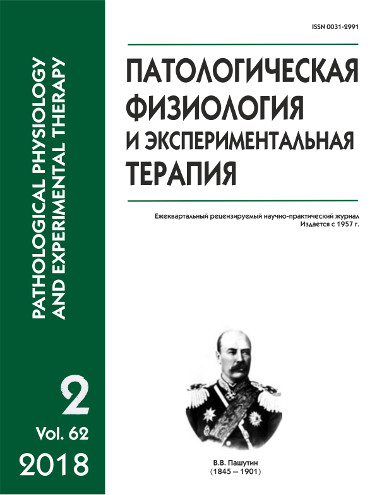The first experience of using extracorporeal magnetic stimulation in the treatment of anal sphincter failure
Abstract
Aim. Since clear algorithms for conservative treatment of anal incontinence are unavailable while advantages of the multimodal therapy have been proven, the aim of this study was to compare two complex programs of conservative treatment of anal sphincter failure. The programs included study-specific protocols of anal electrostimulation or extracorporeal magnetic stimulation as one of treatment components. Methods. The study included 59 patients with anal sphincter failure. The first group, which consisted of 22 patients (20 (90.9%) women and 2 (9.1%) men; mean age, 50.9 ± 5.1), underwent anal electrostimulation combined with biofeedback therapy and tibial neuromodulation. The second group, which consisted of 37 patients (33 (89.2%) women and 4 (10.8%) men; mean age, 51 ± 4.4), underwent extracorporeal magnetic stimulation combined with biofeedback therapy and tibial neuromodulation. Results. For 22 patients of the first group, pretreatment values of perianal sphincter tone and contractility were 33.3 ± 2.8 mm Hg at rest and 77.3 ± 16.0 mm Hg during a strong voluntary contraction; posttreatment values increased to 42.6 ± 4.2 mm Hg and 99.5 ± 19.2 mm Hg, respectively, i.e., the anal canal pressure increased by 27.9% and 28.7%, respectively. For 37 patients of the second group, pretreatment values of perianal sphincter tone and contractility were 32.4 ± 2.0 mm Hg and 91.4 ± 9.5 mm Hg; posttreatment values increased to 40.9 ± 3.0 mm Hg and 109.8 ± 11.9 mm Hg, i.e., the anal canal pressure increased by 26.2% and 20.1% at rest and during a strong contraction, respectively. Discussion. The conservative rehabilitation was beneficial for the anal sphincter in patients with anal incontinence by increasing both tone and contractility of perianal sphincters, which is clinically highly important. Statistically significant differences in increments of pressure values between groups of patients with colorectal and magnetic stimulation were absent.
Downloads
References
2. Il'kanich A.Ya., Slepykh N.V., Barbashinov N.A., Abubakirov A.S. The experience of using anal swabs "Koloplast" in patients with anal incontinence. Koloproctologiya. 2013; 4(46): 35-7. (in Russian)
3. Norton C., Chelvanayagam S., Wilson-Barnett J. et al. Randomized controlled trial of biofeedback for fecal incontinence. Gastroenterology. 2003; 125: 1320–9.
4. Heymen S., Scarlett Y., Jones K. et al. Randomized controlled trial shows biofeedback to be superior to alternative treatments for fecal incontinence. Dis Colon Rectum. 2009; 52: 1730–37.
5. Fynes M.M., Marshall K., Cassidy M. et al. A prospective, randomized study comparing the effect of augmented biofeedback with sensory biofeedback alone on fecal incontinence after obstetric trauma. Dis Colon Rectum. 1999; 42: 753–61.
6. Miner P.B., Donelly T.C., Read N.W. Investigation of the mode of action of biofeedback in treatment of fecal incontinence. Dig Dis Sci. 1990; 35: 1291–8.
7. Schwandner T., Konig I.R., Heimerl T. et al. Triple target treatment (3T) is more effective than biofeedback alone for anal incontinence: the 3T-AI study. Dis Colon Rectum. 2010; 53: 1007–16.
8. Pucciani F., Iozzi L., Masi A. et al. Multimodal rehabilitation for faecal incontinence: experience of an Italian centre devoted to faecal disorder rehabilitation. Tech Coloproctol. 2003; 7: 139–47.
9. Vonthein R., Heimerl T., Schwandner T. et al. Electrical stimulation and biofeedback for the treatment of fecal incontinence: a systematic review. Int J Colorectal Dis. 2013; 28: 1567.
10. Shelygin Yu.A., Fomenko O.Yu., Titov A.Yu., Veselov V.V., Belousova S.V., Aleshin D.V. The sphincterometric pressure in the anal canal is normal. Koloproctologiya. 2016; 2(56): 32-6. (in Russian)
11. Shelygin Yu.A., Fomenko O.Yu., Titov A.Yu., Berseneva E.A., Mudrov A.A., Belousova S.V. Sphincterometric gradation of anal sphincter failure. Koloproctologiya. 2016; 4(58): 54-9. (in Russian)
12. Jorge J.M., Wexner S.D. Etiology and management of fecal incontinence. Dis Colon Rectum. 1993; 36(1): 77-97.
13. Lestar B, Penninckx F, Rigauts H, Kerremans R. The internal anal sphincter can not close the anal canal completely. Int J Colorectal Dis. 1992; 7(3): 159-61.
14. Yoo S.Y., Bae K.S., Kang S.J. et al. How important is the role of the internal anal sphincter in fecal continence? An experimental study in dogs. J Pediatr Surg. 1995; 30(5): 687-91.






